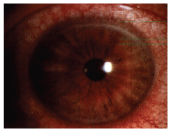Melatonin therapy may be used to prevent ocular inflammation caused by uveitis, according to a study in the December issue of The American Journal of Pathology.
Uveitis could be treated with melatonin, without the side effects of steroids, say researchers who tested it in hamsters.
Typically, corticoid steroids are used to treat uveitis; however, their long-term application may cause several negative side effects, such as glaucoma and cataracts.

Photo courtesy: Lloyd Pate, O.D.
In this study, the authors subcutaneously implanted a pellet of melatonin in hamsters with chemically-induced uveitis. At both 24-hour and eight-day follow-up, melatonin treatment reduced clinical signs of uveitis, such as dilation of the iris and conjunctival vessels, and anterior chamber flare. Also, no morphological changes in photoreceptor outer segments were observed in eyes treated with melatonin. In addition, melatonin therapy reduced levels of tumor necrosis factor-alpha and nuclear factor kappa-B, which are widely responsible for ocular inflammation associated with uveitis.
The authors conclude that melatonin prevents the clinical and functional symptoms of induced uveitis and suggest that it is a viable therapeutic treatment strategy for the condition.
These results are very promising, says Bruce Muchnick, O.D., chief of optometry at the
Less certain is the ultimate delivery method for melatonin. In this study, the authors used a pellet of melatonin, which might not be practical for human application. Melatonin has a very short half-life and demonstrates rather limited bioavailability, Dr. Muchnick says. In the future, melatonin would most likely be administered as a drop and could be combined with a topical steroid.
Sande PH,

